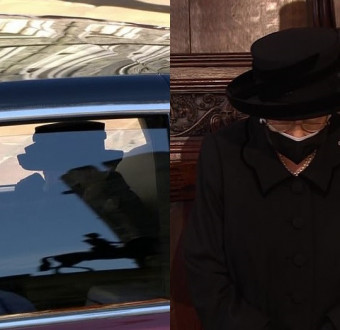Britain’s Prince Philip was laid to rest on Saturday after a ceremonial funeral held at Windsor Castle on Saturday.
Queen Elizabeth II’s husband for 73 years and the Duke of Edinburgh had died on April 9.
The “Ceremonial Royal Funeral” held at St George Chapel was attended by only 30 family members because of the UK government’s COVID-19 restrictions.
Those who attended the funeral alongside the queen included the deceased prince’s four children, two grandchildren, and other family members.
The funeral started with a short procession that carried the coffin to the chapel on a modified land rover. Prince’s four children and two grandsons took part in the procession, which ended on the landing of the chapel, where a minute of silence was held at 3 p.m. (1400GMT).
The coffin of Prince Philip was covered with his personal standard – a personal flag – and surmounted with his sword, naval cap, and a wreath of flowers.
The King’s Troop Royal Horse Artillery fired minute guns for the duration of the procession and The Curfew Tower Bell also tolled.

The service inside the chapel, which was attended by the queen and accompanying family members, was conducted by the Dean of Windsor.
Throughout the funeral, military bands and the choir performed pieces especially selected by the prince who had planned the event before his death.
The service ended at around 4 p.m. as the Duke of Edinburgh’s coffin was lowered into the Royal Vault in the chapel.
The queen was seen in public for the first time since her husband died.
Prince Philip, the Duke of Edinburgh, was 99 when he died a short while after he left hospital following a treatment.
He was married to the queen for the past 73 years.

War hero and modernizer
On the Greek island of Corfu in 1921, Philip was born as Prince Philip of Greece and Denmark.
At 18 years old, he joined the British Royal Navy as a cadet.
This led him to see active service for Britain during the Second World War with bravery, being engaged everywhere from the Indian Ocean to the Mediterranean.
Two years after the war, in 1947, Prince Philip renounced his Greek and Danish royal titles and gave up his career in the Royal Navy in order to marry then-Princess Elizabeth.
Ahead of the marriage, he took up the surname Mountbatten and became a naturalized British subject.
The marriage was a significant occasion for many reasons, not least that it was the first major – and positive – state occasion after the devastation and brutality of the Second World War.
With the queen, Prince Philip had four children: Charles, Anne, Andrew, and Edward.
Known publicly for his gruff manner, Prince Philip was nevertheless a loved and respected father, grandfather, and great-grandfather.
The queen described him as her “constant strength and stay.”
Prince Philip was also notably a modernizer in the staunchly traditionalist and sometimes stubborn Royal Family institution, and he pushed for innovations where possible, such as taking royal walkabouts and holding informal palace lunches where guests from diverse backgrounds were invited.
He was also known for his advocacy and support for young people, and as such created the UK’s most well-known young persons’ program: the Duke of Edinburgh Awards Scheme.
He occasionally garnered controversy with spontaneous politically incorrect comments, but these were always understood in the context of a man who came of age in a far different era.
Since the 1940s, Prince Philip has been a key feature of British public life and will be remembered for his service to both queen and country.

